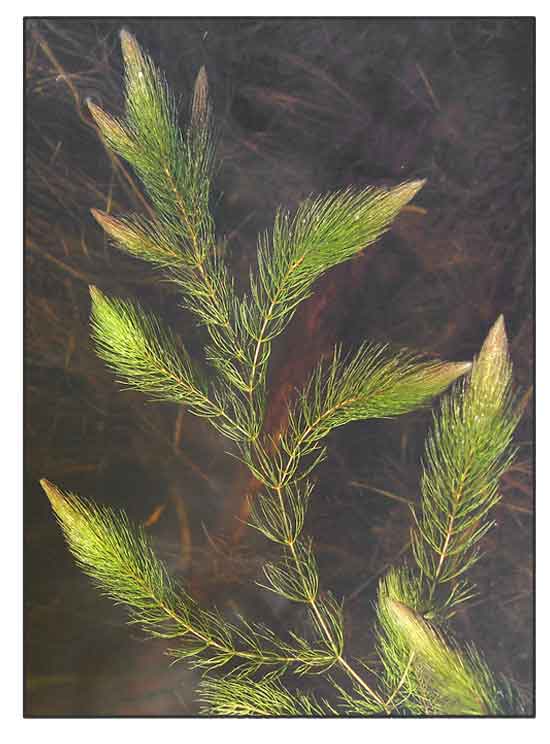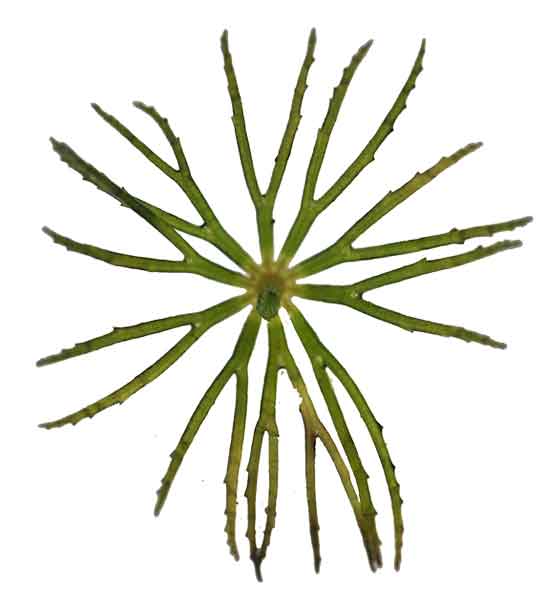 Gen info Gen info
- Ceratophyllum demersum is a species of submerged free-floating aquatic plant, with a cosmopolitan distribution, native to all continents except Antarctica.
-
Etymology: The genus Ceratophyllum derives from Greek keras, 'horn" and phyllon, "leaf", referring to the antler-like structure of the leaf branches. The specific epithet demersum derives from Latin demerge, "sink or plunge", alluding to the submerged growth habit of the plant. (4)
- A popular aquarium plant.
- Considered a harmful weed in New Zealand.
Botany
• An aquatic plant, Ceratophyllum demersum has stems that reach lengths of 1–3 m (3–10 ft), with numerous side shoots making a single specimen appear as a large, bushy mass. Leaves are produced in whorls of six to twelve, each leaf 8–40 mm long, simple, or forked into two to eight thread-like segments edged with spiny teeth; they are stiff and brittle. Monoecious with separate male and female flowers produced on the same plant. The flowers are small, 2 mm long, with eight or more greenish-brown petals; they are produced in the leaf axils. Fruit is a small nut 4–5 mm long, usually with three spines, two basal and one apical, 1–12 mm long. Plants with the two basal nut spines very short are sometimes distinguished as Ceratophyllum demersum var. apiculatum (Cham.) Asch., and those with no basal spines sometimes distinguished as Ceratophyllum demersum var. inerme Gay ex Radcl.-Sm. It can form turions: buds that sink to the bottom of the water that stay there during the winter and form new plants in spring.
Distribution
- Native to the Philippines.
- Native range of the species is Cosmopolitan, native to all continents except Antartica.
 Constituents Constituents
- Plant extracts have yielded different classes of phytomolecules such as alkaloids, cardiac glycoside, glycosides, tannins, and flavonoids.
- Proximate analysis (% of dry weight) includes dry matter (6.9%), crude protein (15.8), ash (25.3), crude fat (3.0), crude fiber (20.7), nitrogen free extract (35.2). (3)
- Steam distillation of leaves yielded 0.15% essential oil. Main components include 2-Methylpropanoic acid 3-hydroxy- 2,4,4-trimethylpentyl ester (>15%), 2-methylpropanoic acid 2,2-dimethyl-1-(2-hydroxy-1-methylethyl)propyl ester (>3%), β-ionone-5,6-epoxide (>7%), toluene (>6%), hexanal (>5%) and 1,2-benzenedicarboxylic acid di(2-methylpropyl) ester (>5%). (3)
- HPLC-QTOF-MS/MS analysis of 70% methanol extract identified 80 compounds, including 8 organic acids, 11 phenolic acids, 25 flavonoids, 21 fatty acids, and 15 others. (see study below) (6)
- Preliminary phytochemical screening of ethanol extracts yielded alkaloids, flavonoids, glycosides, saponins, sterols, tannins, and reducing sugars. (see study below) (7)
- GC and GC-MS study evaluated leaves from Ceratophyllum demersum and Vallisneria spiralis for essential oil. C. demersum had a yield of 0.15%. About 50 constituents were identified, representing 87% of total oils. Main components were basically the same for the two plants, with major components of 2-Methylpropanoic acid 3-hydroxy-2,4,4-trimethylpentyl ester (>15%), 2-methylpropanoic acid 2,2-dimethyl-1-(2-hydroxy-1-methylethyl)propyl ester (>3%), β-ionone-5,6-epoxide (>7%), toluene (>6%), hexanal (>5%) and 1,2-benzenedicarboxylic acid di(2-methylpropyl) ester (>5%) . (12)
 Properties Properties
- Studies have suggested antioxidant properties, anti-diarrheal, wound healing, phytoremediative,
anticancer, α-glucosidase inhibitory, analgesic, antipyretic, anti-inflammatory properties.
Parts used
Leaves, juice, whole plant parts.
Uses
Edibility
- Leaves are edible.
Folkloric
- Plant juice mixed with sesamum oil used for discolored skin. Plant decoction drank for biliousness and ulcers.
-
In Indian medicine, used for jaundice, scorpion stings, as antipyretic and antimalarial. (3)
-
In China, used for hemoptysis.
-
Whole plant used for treatment of wounds, fever, hemorrhoids, intrinsic hemorrhages, epistaxis, hyperdipsia, hematemesis. Also used for dizziness, leucorrhea, morbid thirst, rheumatism, spermaturia, venereal disease. Leaf juice used to stop vomiting. (3)
Studies
• Antioxidant: Study evaluated the antioxidant activities of water and methanol extracts of invitro propagated C. demersum. Antioxidant contents (ß-carotene, flavonoid, lycopene, and total phenols), metal chelating, and reducing power were investigated. The water extract was more effective in all activities. Total phenols (76.55 µg/ml) were the highest antioxidant component. IC50 for chelating ferrous ions was 9.24 mg/mL, EC 50 fir reducing power activity was 8.23 mg/mL. Results showed beneficial antioxidant properties and a promising source of therapeutics. (5)
• Ultrasound-Assisted Extraction of α-Glucosidase Inhibitors: Study reports an ultrasound-assisted optimized extraction of α-glucosidase inhibitors from C. demersum. A 70% methanol extract showed lowest IC50 (0.15 mg dried material) for α-glucosidase inhibition, which was lower than acarbose (IC50 0.64 mg DM/ml). Results suggest a potential source of α-glucosidase inhibitors. (see constituents above) (6)
• Anticancer / HT-29 Human Colon Cancer Cell Line: Study of C. demersum ethanol extracts exhibited noteworthy antioxidant activity using DPPH, ferric ion reducing power assay and phosphomolybdenum assay. Ethanol extract showed cytoxicity to HT-29 human colon cancer cell line. (see constituents above) (7)
• Antidiarrheal / Wound Healing / Whole Plant: Study evaluated methanolic and aqueous extracts of whole plant of Ceratophyllum demersum for antidiarrheal and wound healing potentials using experimental rat models. Both extracts showed significant antidiarrheal activity at doses of 250 and 500 mg/kg in castor oil and magnesium sulfate induced diarrhea in rats in parameters of total number of feces, number of wet feces, % inhibition of defecation and diarrheic drops. In excision wound model, both extracts in 5% w/w simple ointment formulation showed wound healing activities in measures of % wound closure and epithelization time. Results support use of the whole plant in traditional medicine for treatment of wounds and diarrhea. (8)
• Bioaccumulation of Heavy Metals / Cadmium: Study evaluated the accumulation and tolerance of C. demersum to different concentrations of Pb+2, Al+3, and Cd+2 during four treatment periods for 16 days. Maximum BCF value of Cd in C. demersum at low concentration was 1295.37 after 12 days of treatment. Results suggest C. dermersum can be considered a hyperaccumulator species for cadmium and suitable for phytoremediation. (9)
• Water Purification Effect / Change of Microbial Community: Study evaluated the purification effect of submerged macrophyte C. demersum on still water in cold region and its microbial community change under planting diversity and different aeration treatments. Results showed better water purification effect when plant density of CD was 4.44 g/L with 12 h aeration treatment. Removal rate of total nitrogen (TN) and total phosphorus (TP) was 1.23% and 89.27%, respectively. Overall, diversity of microbial community did not increase. Dominant phyla were Proteobacteria, Bacteroidetes and Actinobacteria. Relative abundance of dominant phylum could be increased by proper addition of C. dermesum, but relative abundance of Proteobacteria and Bacteroidetes could be reduced by aeration treatment. Compared with effect of TN and TP concentration changes, adding C. demersum and aeration treatment had more significant effect on microbial dominant groups. (10)
• Analgesic / Antipyretic / Anti-Inflammatory / Whole Plant: Study evaluated a methanolic extract of whole plant of C. demersum using doses of 250 and 500 mg/kg and acetic acid, Brewer's yeast and carrageenan to induce algesic, pyrexia, and inflammation in Wistar albino rats. The extract showed significant analgesic, antipyretic and anti-inflammatory activities. Flavonoids in the ME may be contributory to the activities. (11)
• Anti-Leishmanial / Antibacterial / Cytotoxic: Study evaluated phenolic compounds from methanol extract of plant at concentrations of 25, 50, 100, 200, 400, and 800 µg/ml for anti-leishmanial, anticancer, and antibacterial activities. Extract showed maximum inhibition activity against Leishmania donovani at 800 µg/ml concentration. Extract also showed growth inhibition of E. coli (22 mm) and Bacillus cereus (17 mm) and highly effective inhibitory activity of 70.6% on L20B cell line (highly sensitive and specific to polioviruses) at concentration of 800 µg/ml. (13)
• Activated Charcoal for Acute Poisonings: Activated charcoal is used to treat many forms of oral poisonings from poisoned foods, medicines, drub overdosing, etc. Study reports on the use of plant waste products and conversion to charcoal by microwave pyrolysis and its use for treatment of acute poisoning. Study showed that with increasing temperature, the area of activated charcoal increases and becomes more porous, which leads to greater absorption of the toxic substance. A higher BET (Brunauer -Emmer-Teller) surface area of 9519 m2/g was achieved when producing activated charcoal at temperature of 650°C. (14)
• Phytoremediation / PHE (Potentially Hazardous Elements): PHE are non-biodegradable and accumulate in places like water, soil, and plants to endanger environmental health. Study evaluated PHE accumulation, sediments and C. demersum in a basin with intense hazelnut and rice farming. All PHEs analyzed, except for Cd, displayed a bioconcentration factor (BCF) value of more than 1000, indicating C. demersum is a promising plant for phytoremediation in PHE-polluted ecological systems involving wetlands, and can be employed as indicator species in biological screening studies. (15)
• Attenuation of Microbial Induced Deterioration of Cellulose Fibers / Stems and Leaves: Study isolate bacteria and fungi from an infected manuscript dated back to the 8th century kept at the Al-Azhar library in Cairo Egypt. The manuscript material was made from cellulose fibers. Three bacterial species, B. subtilis, B. megaterium, and Streptomyces sp. and five fungal species, A. niger, A. flavus, P citrinum, A. alternata, and A. kilinase were isolated. A methanol extract of stems and leaves showed remarkable inhibition in growth of isolated bacteria and fungi. Treating of modern Rakta papers with C. demersum extracts showed amelioration of physical and mechanical properties of the papers. Resistance against microbial attack of Rakta papers was increases after treatment with C. demersum extract. (16)
• Anthelmintic Polyherbal Formulation: Study evaluated the anthelmintic activity of a polyherbal formulation containing Ceratophyllum demersum leaves, T. populnea bar, T. alata bark, C. triloba roots using adult earthworm Pheretima posthuma. Piperazine citrate was used as standard. Results showed anthelmintic activity is measures of paralysis time and time to kill. The ethanolic extract showed higher activity than the aqueous extract. (17)
• Antiulcer / Antidiarrheal / Wound Healing: Study showed Ceratophyllum demersum possesses significant antiulcer, antidiarrheal, and wound healing activities, which scientifically support its traditional use for treatment of ulcers, diarrhea, and wound conditions. (18)
• Phytoremediation / Removal of Methylene Blue: Study evaluated the ability of aquatic plant Coontail (C. demersum) to remove methylene blue (MB) dye. The removal percentage was up to 96% for 5 days. Results suggest strong potential as a phytoremediation agent to remove dyes from wastewater treatment system. (19)
Availability
Wild-crafted.
Plants in the cybermarket. |

![]()






